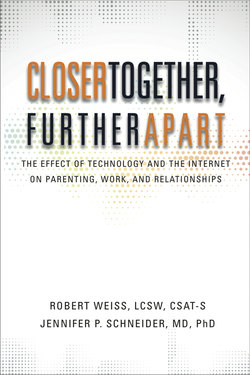Читать книгу Closer Together, Further Apart: The Effect of Technology and the Internet on Parenting, Work, and Relationships - Jennifer Schneider - Страница 13
На сайте Литреса книга снята с продажи.
CHAPTER ONE The New Generation Gap
ОглавлениеEverything comes and goes
Marked by lovers and styles of clothes
Things that you held high
And told yourself were true
Lost or changing as the days come down to you
—Joni Mitchell, Down to You
Generally speaking, people born before 1980 are considered to be digital immigrants, and those born after 1980, digital natives.1 Digital natives are people who grew up actively using and engaging with computers and the Internet, while digital immigrants did not. While this arbitrary 1980 dividing line is not a hard-and-fast rule, typically, digital natives unquestioningly appreciate and value the role that digital technology plays in their lives, whereas digital immigrants hold mixed views about how modern communications technology has impacted their lives. To better understand this concept, consider the following two situations.
Situation one: A group of friends are at a busy restaurant. Everyone at the table is under age twenty-eight (digital natives). Several people are chatting with each other in conversation, while others appear to be fully engaged with their digital communication devices—texting, tweeting, and dropping in on Facebook. Everyone looks relaxed. There seems to be no hurry or worry about who is available to talk or what others are doing. The group appears as a whole to understand that being digitally preoccupied, while also at dinner with friends, is acceptable, typical, and routine. The devices and people at the table have near equal status.
Situation two: A more age-differentiated group of people are sitting at a table at that same restaurant. About half of the people are forty-five or older (digital immigrants), while the rest of the group are younger professionals in their late twenties (digital natives). Several people are chatting with each other in active conversation, while others appear to be fully engaged with their digital communication devices. Unlike situation one, there is tension at this table. Several of the older diners are clearly annoyed with the younger adults. They look over at them impatiently, lips pursed, feet tapping under the table. Eventually one of the digital immigrants turns to the woman next to her and says, “When did a phone become more important than a human being?” Her same-age friend clucks and nods.
If these scenarios sound familiar, then you are getting a sense of the electronic media-based generational divide that is a strong theme throughout the book.
This rapidly widening separation between digital natives and digital immigrants has created a new generation gap. This gap has introduced conflicting methodologies and ideologies that ultimately affect nearly every facet of modern life. There are differences in the ways digital natives and digital immigrants conduct business and gather news and information, as well as how they both earn and spend their paychecks. Digital natives and digital immigrants can also differ significantly in the ways they define personal privacy, how they experience entertainment (music, books, and movies), even the ways they socially engage—including flirting, romancing, and having sex.
Scaling back to view the big picture, it becomes increasingly clear that in nearly every arena outside of face-to-face interactions, our basic forms of interpersonal communication and social connection have been utterly reformatted in a mere two to three decades. In some ways this sounds much like every other generation gap in history. However, previous generation gaps have mostly centered on younger people hearing and seeing the older generation but ultimately rejecting and/or devaluing their ideas and beliefs. Today’s generation gap is more about the younger generation being literally and figuratively separated from the older generation in many, if not most, aspects of their lives. In other words, digital natives often neither see nor hear their elders because, from a communications standpoint, digital immigrants and digital natives are literally “not in the same room.”
Baby boomers will certainly remember the 1960s mantra “Don’t trust anyone over thirty,” first uttered by activist Jack Weinberg in relation to the Free Speech Movement. Today the mantra might be “Where are the people over thirty?” If you don’t text, email, spend time on Twitter or Facebook, or blog, then you’re not communicating or interacting with younger people. They simply don’t know you exist.
